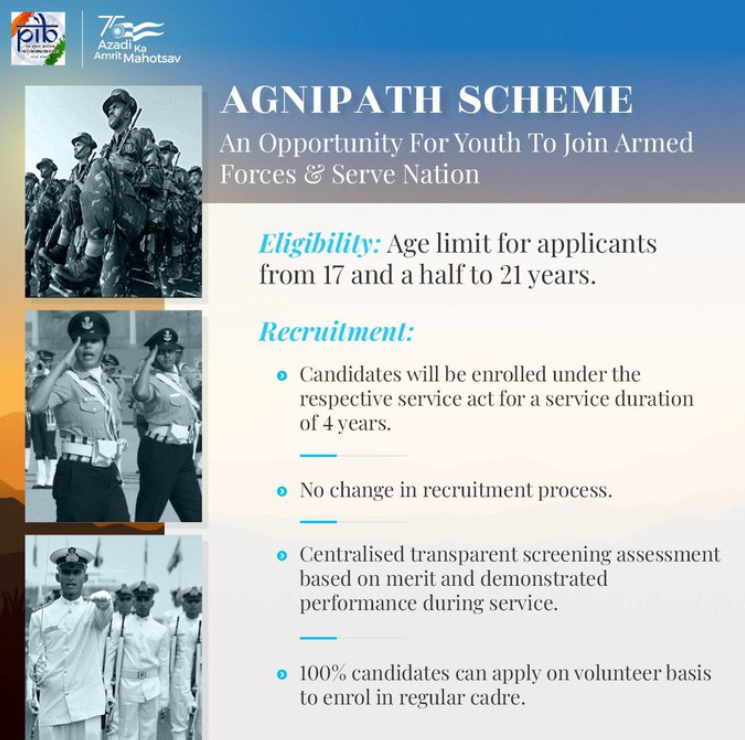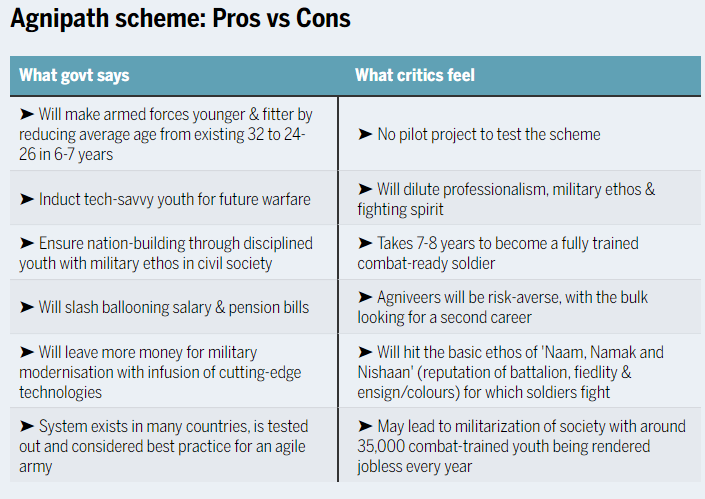Agnipath scheme
2022 JUN 18
Mains >
Security > Border area management > Security forces and Police

IN NEWS:
- Protests against the new Agnipath scheme for recruitment of soldiers on a short-term contractual basis have turned violent in many places across India.
AGNIPATH SCHEME:
- Under the scheme, young persons will be provided an opportunity to serve in the armed forces as Agniveer for a period of 4-years, which included the training period.
- Agniveers will be enrolled in the Forces under respective Service Acts for a period of four years, which includes the training period.
- They would form a distinct rank in the Armed Forces, different from any other existing ranks and below that of officers.
Qualification:
- Men and women between the ages of 17.5 and 21 years will be recruited under the scheme.
- Since recruitments have not happened in last 2 years, Centre has revised the upper age limit for Agniveers, extending it to 23 years as a one-time measure.
Recruitment process:
- Enrolment will be undertaken through an online centralised system for all three services with specialised rallies and campus interviews from recognised technical institutes such as Industrial Training Institutes and National Skills Qualifications Framework, among others.
- 46,000 Agniveers will be recruited this year. Enrolment will be based on ‘All India, All Class’ basis.
- The first Agnipath entry rally recruitment will start from September – Oct 2022.
Upon completion of 4 years:
- After four years, Agniveers will be offered an opportunity to apply for permanent enrolment in the Armed Forces:
- These applications will be considered in a centralised manner.
- Based on merit, organisation requirement and medical fitness, up to 25 percent shall be selected from that batch. They will then serve for a full term of another 15 years.
- The other 75% will be demobilised, with an exit or “Seva Nidhi” package of Rs 11-12 lakh, partly funded by their monthly contributions, as well as skill certificates and bank loans for help in their second careers.
SIGNIFICANCE OF THE SCHEME:

- Utilise demographic dividend:
- The move is aimed at lowering the average age of the soldier. It is a game-changer that will give the Army, Navy, and Air Force a more youthful image.
- Opportunity to serve the country:
- The new policy provides a once-in-a-lifetime opportunity for the youth to serve their country and contribute to national development.
- Strengthen military numbers:
- The number of Agniveers to be recruited in the first year would make up 3% of the armed forces. The recruitment will rise three-fold in the coming years. This will improve the strength of our forces.
- Reduce military expenses:
- Currently, more funds are being spent on salaries and pensions rather than on much-needed military modernization. The scheme, through the Seva Nidhi package, will reduce this burden.
- Human resource development:
- Those among the 75% wishing to be entrepreneurs will get a financial package, bank loans, bridge course for further studies, priority in jobs in Defence ministry, Central Armed Police Forces (CAPFs) and the State police. Several avenues are also being opened up for them in other sectors. This will help address the skill deficit and unemployment issues in the country.
- Enhances social capital:
- The Agniveers will have a good financial package with the opportunity to train in the best military ethos in civil society and institutions, as well as improve their skills and qualifications. This will make well-disciplined and skilled youth with military ethos in the civil society.
- International examples:
- Such short-term enlistment system exists in many countries. It is considered best practice for a youthful and agile army.
- For eg: In US, most personnel enroll for four years, which is followed by a four-year reserve duty period. Soldiers can also opt for full service and are eligible for pensions after serving for 20 years.
CONCERNS OVER THE SCHEME:
- Threat to professionalism among forces:
- Army veterans have raised concern that 4 years is inadequate to inculcate regimental ethos, affiliation, and discipline. 4 year contractual period militates against integration in unit and could make men risk averse.
- Shorter training period:
- It takes two to three years to train a member of the army. But under Agnipath, soldiers will only be trained for six months. There are questions over how ready agniveers will be after just six months of training.
- With India facing threats from both Pakistan and China, the country cannot afford to not train the different units of its army properly.
- Question over future of Agniveers:
- Though there are reservations in recruitments, ex-servicemen finding jobs is still a problem in the country. These newly retiring soldiers might add to that queue.
- Untested in India:
- The concept of Tour of Duty has not been tested in India. Hence, critics argue that the scheme should have been tried out as a small project initially.
- Militarization of civil society:
- With around 35,000 combat-trained youth being rendered jobless every year, the scheme may lead to militarization of society.
PRACTICE QUESTION:
Q. Agnipath scheme envisages promotion of nationalism in the youth, offering skilled manpower to the society and ensuring a more youthful profile of the Army. Elaborate?

